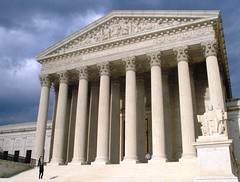We retired Tax Justice Blog in April 2017. For new content on issues related to tax justice, go to www.justtaxesblog.org
So the modest fee that the Affordable Health Care Act  will impose on people who choose not to have health insurance is a “tax,” according to a majority of Supreme Court justices. Hooray! That characterization made the Act pass constitutional muster even in the opinion of this very conservative Supreme Court.
will impose on people who choose not to have health insurance is a “tax,” according to a majority of Supreme Court justices. Hooray! That characterization made the Act pass constitutional muster even in the opinion of this very conservative Supreme Court.
There’s more good news. It’s a tax that hardly anyone will pay.
That’s because for the vast majority of Americans who don’t have employer health coverage, the government subsidies to buy insurance will be so large that it would be foolish not to buy insurance.
For starters, any family with income less than 133 percent of the poverty line (that means all families of four with incomes of $30,000 or less) will be eligible to sign up for free coverage under Medicaid.
Above that level of income, the government will provide cash subsidies to buy insurance, starting at almost 100 percent of the cost and gradually phasing down. But the subsidies won’t disappear for a family of four until its income exceeds about $90,000.
For example, a family of four earning $50,000 that buys health insurance will get a government subsidy equal to 60-70 percent of the cost of the premiums.
Because of these large subsidies to buy insurance, it’s estimated that the new “tax” on those who fail to get health insurance will apply to less than 3 percent of all households. So don’t worry. You’re almost certainly not one of them.
Nonsensical Claim of Largest Tax Increase in History
Some opponents of the health care reform law have taken to calling it the largest tax increase in history. The fee for not having health insurance would be, of course, relatively small, raising around $7 billion a year (just 0.03 percent of GDP) and increasing federal revenue by 0.15 percent (one sixth of one percent).
Even if you count all the tax increases in the health law, that still amounts to less than the tax increases President Reagan enacted from 1982 through 1983. When you subtract the tax cuts (the refundable credits to help families obtain health insurance and the tax credits for small businesses) the net effect of the law is to increase taxes by $653 billion over the next decade, which is about 0.3 percent of GDP. By way of comparison, from 1982 through 1983, President Reagan raised taxes by 1.8 percent of GDP. (And of course, there were much larger tax increases in our history, like the tax increase during World War II that equaled 14.8 percent of GDP.)
It’s also important to note that about three-fourths of the tax increases in the health reform law apply to corporations (drug companies, medical device manufacturers, insurance companies) and married couples making over $250,000 and single people making over $200,000.
Health Reform Law Includes a Major Win for Tax Fairness
The tax increase on high-income individuals is particularly important because it reduces the bias in the tax code in favor of investment income and against income from work.
This provision, which was proposed in 2009 by Citizens for Tax Justice, reforms the Hospital Insurance (HI) tax that funds part of Medicare so that it’s more progressive and no longer exempts the income of people who live off their investments. The HI tax will effectively have a top rate of 3.8 percent that applies to both earnings and most investment income, and which only applies to taxpayers with incomes in excess of $250,000/$200,000.
This provision reduces, but does not eliminate, the ability of people who live off their investments to have a lower effective tax rate than people who live on earnings. It’s another reason why the health law is victory for middle-income working Americans.
Photo of Supreme Court via OZ in OH Creative Commons Attribution License 2.0